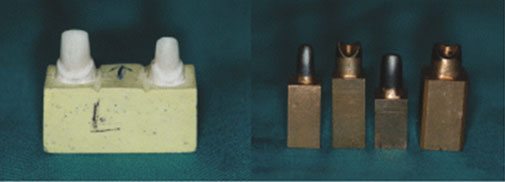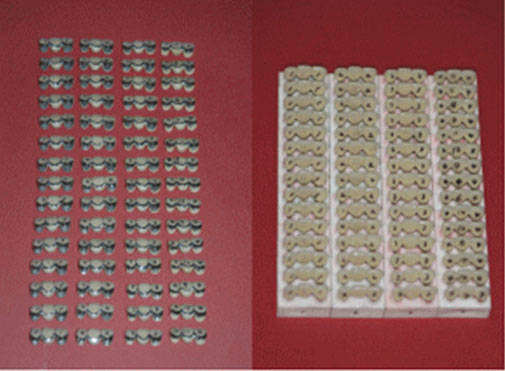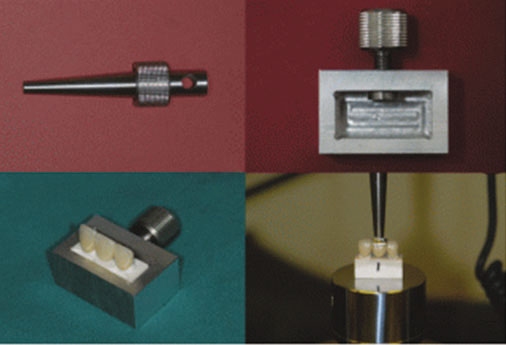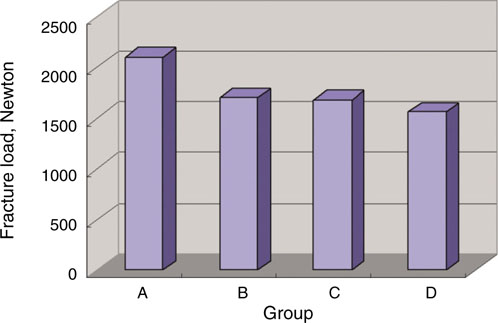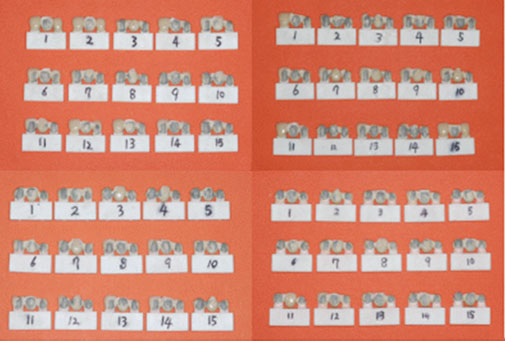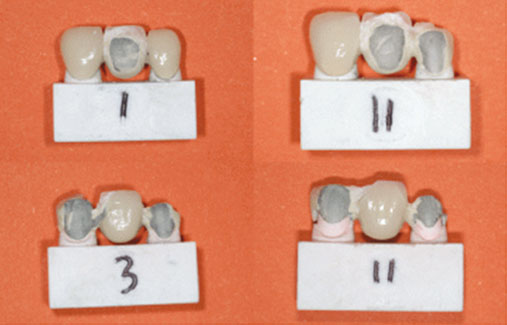J Adv Prosthodont.
2010 Dec;2(4):134-141. 10.4047/jap.2010.2.4.134.
A study on the fracture strength of collarless metal-ceramic fixed partial dentures
- Affiliations
-
- 1Department of Prosthodontics, Graduate School, Seoul National University, Seoul, Korea. jhoyang@snu.ac.kr
- KMID: 1975188
- DOI: http://doi.org/10.4047/jap.2010.2.4.134
Abstract
- PURPOSE
The objective of this study was to evaluate fracture strength of collarless metal-ceramic FPDs according to their metal coping designs.
MATERIALS AND METHODS
Four different facial margin design groups were investigated. Group A was a coping with a thin facial metal collar, group B was a collarless coping with its facial metal to the shoulder, group C was a collarless coping with its facial metal 1 mm short of the shoulder, and group D was a collarless coping with its facial metal 2 mm short of the shoulder. Fifteen 3-unit collarless metal-ceramic FPDs were fabricated in each group. Finished FPDs were cemented to PBT (Polybutylene terephthalate) dies with resin cement. The fracture strength test was carried out using universal testing machine (Instron 4465, Instron Co., Norwood MA, USA) at a cross head speed of 0.5 mm/min. Aluminum foil folded to about 1 mm of thickness was inserted between the plunger tip and the incisal edge of the pontic. Vertical load was applied until catastrophic porcelain fracture occurred.
RESULTS
The greater the bulk of unsupported facial shoulder porcelain was, the lower the fracture strength became. However, there were no significant differences between experimental groups (P > .05).
CONCLUSION
All groups of collarless metal-ceramic FPDs had higher fracture strength than maximum incisive biting force. Modified collarless metal-ceramic FPD can be an alternative to all-ceramic FPDs in clinical situations.
Keyword
MeSH Terms
Figure
Reference
-
1. Geller W. Dark and shaded zones-one of the important aspects of the W. Geller creative color technic. Quintessenz Zahntech. 1982. 8:467–473.2. Touati B, Miara P. Light transmission in bonded ceramic restorations. J Esthet Dent. 1993. 5:11–18.3. Cornell DF. Soft tissue-ceramic interface: true parameter for successful esthetics. J Esthet Dent. 1995. 7:81–86.4. O'Boyle KH, Norling BK, Cagna DR, Phoenix RD. An investigation of new metal framework design for metal ceramic restorations. J Prosthet Dent. 1997. 78:295–301.5. Choung CK, Garlapo DA, Brown MH, Sorensen SE. Procedure for a simplified collarless metal-ceramic restoration using gold powder. J Prosthet Dent. 1982. 47:449–453.6. Behrend DA. Ceramometal restorations with supragingival margins. J Prosthet Dent. 1982. 47:625–632.7. Lehner CR, Männchen R, Schärer P. Variable reduced metal support for collarless metal ceramic crowns: a new model for strength evaluation. Int J Prosthodont. 1995. 8:337–345.8. Ulusoy M, Toksavul S. Fracture resistance of five different metal framework designs for metal-ceramic restorations. Int J Prosthodont. 2002. 15:571–574.9. Yun JW, Yang JH, Chang IT, Lee SH, Chung HY. A study on fracture strength of collarless metal ceramic crown with different metal coping design. J Korean Acad Prosthodont. 1999. 37:454–464.10. Shillingburg HT, Hobo S, Whitsett LD, Jacobi R, Brackett SE. Fundamentals of Fixed Prosthodontics. 1997. 3rd ed. Chicago: Quintessence Publishing;142–148.11. Waltimo A, Könönen M. A novel bite force recorder and maximal isometric bite force values for healthy young adults. Scand J Dent Res. 1993. 101:171–175.12. Kiliaridis S, Kjellberg H, Wenneberg B, Engström C. The relationship between maximal bite force, bite force endurance, and facial morphology during growth. A cross-sectional study. Acta Odontol Scand. 1993. 51:323–331.13. Schneider DM, Levi MS, Mori DF. Porcelain shoulder adaptation using direct refractory dies. J Prosthet Dent. 1976. 36:583–587.14. Goodacre CJ, Van Roekel NB, Dykema RW, Ullmann RB. The collarless metal-ceramic crown. J Prosthet Dent. 1977. 38:615–622.15. Toogood GD, Archibald JF. Technique for establishing porcelain margins. J Prosthet Dent. 1978. 40:464–466.16. Vryonis P. A simplified approach to the complete porcelain margin. J Prosthet Dent. 1979. 42:592–593.17. Prince J, Donovan TE, Presswood RG. The all-porcelain labial margin for ceramometal restorations: a new concept. J Prosthet Dent. 1983. 50:793–796.18. Edge MJ, Maccarone T. An alternate method for establishing porcelain margins. J Prosthet Dent. 1987. 57:276–277.19. Pinnell DC, Latta GH Jr, Evans JG. Light-cured porcelain margins: a new technique. J Prosthet Dent. 1987. 58:50–52.20. Belles DM, Cronin RJ Jr, Duke ES. Effect of metal design and technique on the marginal characteristics of the collarless metal ceramic restoration. J Prosthet Dent. 1991. 65:611–619.21. Boyle JJ Jr, Naylor WP, Blackman RB. Marginal accuracy of metal ceramic restorations with porcelain facial margins. J Prosthet Dent. 1993. 69:19–27.22. Warpeha WS Jr, Goodkind RJ. Design and technique variables affecting fracture resistance of metal-ceramic restorations. J Prosthet Dent. 1976. 35:291–298.23. Smith TB, Kelly JR, Tesk JA. In vitro fracture behavior of ceramic and metal-ceramic restorations. J Prosthodont. 1994. 3:138–144.24. Kheradmandan S, Koutayas SO, Bernhard M, Strub JR. Fracture strength of four different types of anterior 3-unit bridges after thermo-mechanical fatigue in the dual-axis chewing simulator. J Oral Rehabil. 2001. 28:361–369.25. Kern M, Douglas WH, Fechtig T, Strub JR, DeLong R. Fracture strength of all-porcelain, resin-bonded bridges after testing in an artificial oral environment. J Dent. 1993. 21:117–121.26. Rosentritt M, Plein T, Kolbeck C, Behr M, Handel G. In vitro fracture force and marginal adaptation of ceramic crowns fixed on natural and artificial teeth. Int J Prosthodont. 2000. 13:387–391.27. Scherrer SS, de Rijk WG. The fracture resistance of all-ceramic crowns on supporting structures with different elastic moduli. Int J Prosthodont. 1993. 6:462–467.28. Yoshinari M, Dérand T. Fracture strength of all-ceramic crowns. Int J Prosthodont. 1994. 7:329–338.29. Anusavice KJ, Hojjatie B. Tensile stress in glass-ceramic crowns: effect of flaws and cement voids. Int J Prosthodont. 1992. 5:351–358.30. Stangel I, Nathanson D, Hsu CS. Shear strength of the composite bond to etched porcelain. J Dent Res. 1987. 66:1460–1465.31. Tuntiprawon M, Wilson PR. The effect of cement thickness on the fracture strength of all-ceramic crowns. Aust Dent J. 1995. 40:17–21.32. Miller A, Long J, Miller B, Cole J. Comparison of the fracture strengths of ceramometal crowns versus several all-ceramic crowns. J Prosthet Dent. 1992. 68:38–41.33. Nakamura T, Ohyama T, Imanishi A, Nakamura T, Ishigaki S. Fracture resistance of pressable glass-ceramic fixed partial dentures. J Oral Rehabil. 2002. 29:951–955.34. Rinke S, Hüls A, Jahn L. Marginal accuracy and fracture strength of conventional and copy-milled all-ceramic crowns. Int J Prosthodont. 1995. 8:303–310.35. Dickinson AJ, Moore BK, Harris RK, Dykema RW. A comparative study of the strength of aluminous porcelain and all-ceramic crowns. J Prosthet Dent. 1989. 61:297–304.36. Hwang JW, Yang JH. Fracture strength of copy-milled and conventional In-Ceram crowns. J Oral Rehabil. 2001. 28:678–683.37. Wilson PR, Goodkind RJ, Delong R, Sakaguchi R. Deformation of crowns during cementation. J Prosthet Dent. 1990. 64:601–609.
- Full Text Links
- Actions
-
Cited
- CITED
-
- Close
- Share
- Similar articles
-
- A study on the marginal fit of collarless metal ceramic fixed partial dentures
- A STUDY ON FRACTURE STRENGTH OF COLLARLESS METAL CERAMIC CROWN WITH DIFFERENT METAL COPING DESIGN
- FRACTURE STRENGTH AND MARGINAL FIT OF IN-CERAM, COPY-MILLED IN-CERAM, AND IPS EMPRESS 2 ALL-CERAMIC BRIDGES
- Bond and fracture strength of metal-ceramic restorations formed by selective laser sintering
- Fracture strength of zirconia monolithic crowns and metal-ceramic crowns after cyclic loading and thermocycling

